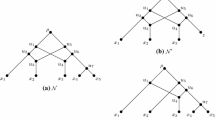Abstract
In order to help infer an evolutionary tree (phylogeny) from experimental data, we propose a new method for pre-processing the corresponding dissimilarity matrix, which is related to the property that the distance matrix of a phylogeny (called an additive matrix) describes a sandwich family of chordal graphs. As experimental data often yield distance values which are known to be under-estimated, we address the issue of correcting the data by increasing the distances which are incorrect. This is done by computing, for each graph of the sandwich family, a maximal chordal subgraph.
Similar content being viewed by others
Explore related subjects
Discover the latest articles, news and stories from top researchers in related subjects.References
Balas E (1986) A fast algorithm for finding an edge-maximal subgraph with a TR-formative coloring. Discrete Appl Math 15:123–134
Barthélémy J-P, Guénoche A (1991) Trees and proximity representations. Wiley (eds), New York
Berry A (1999) A wide-range efficient algorithm for minimal triangulation. In: Proceedings of tenth annual ACM-SIAM symposium on discrete algorithms (SODA'99), 860–861
Berry A, Blair J, Heggernes P (2002) Maximum cardinality search for computing minimal triangulations. In: Kucera L (ed) Graph theoretical concepts in computer science – WG 2002, LNCS 2573, Springer Berlin Heidelberg New York 1–12
Berry A, Bordat J-P, Heggernes P (2000) Recognizing weakly triangulated graphs by edge separability. Nordic J Comput 7:164–177
Berry A, Heggernes P, Villanger Y (2003) An on-line incremental approach for dynamically maintaining chordal graphs. Research Report LIMOS: RR 2003-04
Berry A, Bordat J-P, Heggernes P, Simonet G, Villanger Y (2003) A wide-range algorithm for minimal triangulation from an arbitrary ordering. Technical report reports in informatics 243, University of Bergen (Norway); Research Report LIMOS: RR 2003-02. J Algorithms (submitted)
Berry A, Sigayret A, Sinoquet C (2002) Towards improving phylogeny reconstruction with combinatorial-based constraints on an underlying family of graphs. Research Report LIMOS: RR 02-103
Berry V, Gascuel O (2000) Inferring evolutionary trees with strong combinatorial evidence. Theor Comput Sci 240 2:271–298
Blair JRS, Peyton B (1993) An introduction to chordal graphs and clique trees. Graph Theory Sparse Matrix Comput 56:1–29
Bonnot F, Guénoche A, Perrier X (1996) Properties of an order distance associated with a tree distance. In: Diday E et al (eds) Proceedings of OSDA'95 (Ordinal and Symbolic Data Analysis), Springer Berlin Heidelberg New York 252–261
Brandstädt A, Le VB, Spinrad J (1999) Graph classes – a survey. SIAM monographs on discrete mathematics and applications
Buneman P (1971) The recovery of trees from measures of dissimilarity. Mathematics in the archeological and historical sciences. Edinburgh University Press, 387–395
Buneman P (1974) A characterization of rigid circuit graphs. Discrete Math 9:205–212
Coleman TF (1988) A chordal preconditioner for large-scale optimization. Appl Math 40:265–287
Dearing PM, Shier DR, Warner DD (1988) Maximal chordal subgraphs. Discrete Appl Math 20:181–190
Erdös P, Laskar R (1983) On maximum chordal subgraph. Cong Numerantium 39:367–373
Garetta H, Guénoche A (2001) How confident can we be that a tree representation is good? (Quelle confiance accorder à une représentation arborée?). In: Gascuel O, Sagot M-F (eds) Proceedings of JOBIM 2000, LNCS, vol 2066 Springer Berlin Heidelberg, New York pp 45–56
Gàvril F (1974) The intersection graphs of subtrees of trees are exactly the chordal graphs. J Comb Theory B, 16:47–56
Golumbic MC (1980) Algorithmic graph theory and perfect graphs. Academic Press New York
Guénoche A (1998) Ordinal properties of tree distances. Discrete Appl Math 192:103–117
Hayward R, Hoàng C, Maffray F (1989) Optimizing weakly triangulated graphs. Graphs Comb 5:339–349
Hein J (1989) An optimal algorithm to reconstruct trees from additive distance data. Bull Math Biol 51(5):597–603
Huson D, Nettles S, Warnow T (1999) Obtaining highly accurate topology estimates of evolutionary trees from very short sequences. In: Proceedings of RECOMB'99, Lyon (France), 198–207
Ibarra L (2000) Fully dynamic algorithms for chordal graphs and split graphs. Technical report, University of Victoria DCS-262-IR
Kearney P, Hayward R, Meijer H (1997) Inferring evolutionary trees from ordinal data. In: Proceedings of eighth annual ACM-SIAM symposium on Discrete Algorithms (SODA'97) 418–426
Rose D, Tarjan RE, Lueker G (1976) Algorithmic aspects of vertex elimination on graphs. SIAM J Comput 5:146–160
Spinrad J, Sritharan R (1995) Algorithms for weakly triangulated graphs. Discrete Appl Math 59:181–191
Walter JR (1978) Representations of Chordal Graphs as Subtrees of a Tree. J Graph Theory 2:265–267
Xue J (1994) Edge-maximal triangulated subgraphs and heuristics for the maximum clique problem. Networks 24:109–120
Author information
Authors and Affiliations
Corresponding author
Rights and permissions
About this article
Cite this article
Berry, A., Sigayret, A. & Sinoquet, C. Maximal sub-triangulation in pre-processing phylogenetic data. Soft Comput 10, 461–468 (2006). https://doi.org/10.1007/s00500-005-0507-7
Published:
Issue Date:
DOI: https://doi.org/10.1007/s00500-005-0507-7




